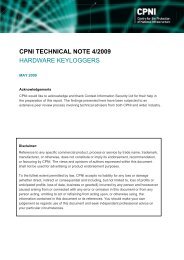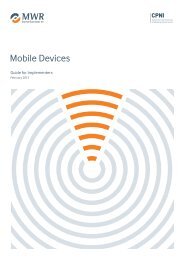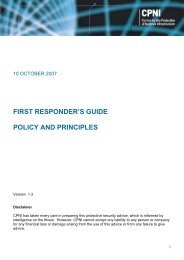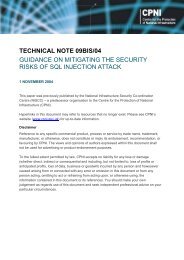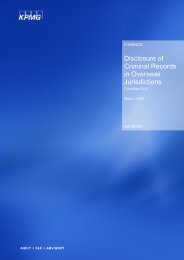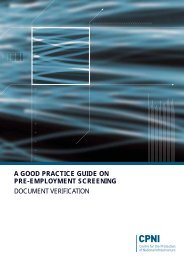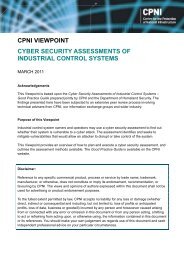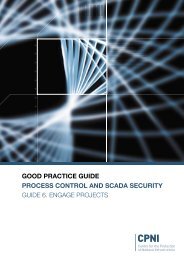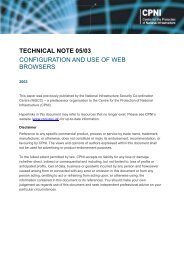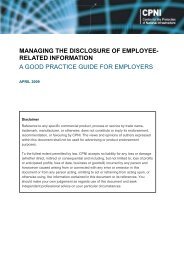Border gateway protocol filtering guidelines - CPNI
Border gateway protocol filtering guidelines - CPNI
Border gateway protocol filtering guidelines - CPNI
You also want an ePaper? Increase the reach of your titles
YUMPU automatically turns print PDFs into web optimized ePapers that Google loves.
Checklist of additional suggested security measures16 Deny inappropriate length RIR allocations17 Deny inappropriate announcements for legacy A/B/C space18 Monitor announcements with “borderline” length prefixes (e.g./6 /28)19 Set max-prefix limits on IXP and customer peerings.20 Implement BGP graceful restart/Cisco Nonstopforwarding or other Cisco GRIP featuresImplemented?
ANNEX B:Other useful information on BGP security1 Summary of Principal Risks1.1 Router failure, or impaired performance.1.2 Blackholing internet traffic to some addresses.1.3 Isolation of internet networks or subnets.1.4 Traffic misdirection/route hijack.1.5 Eavesdropping.1.6 All of these have cost implications for the providers, as well as CNI securityimplications, and all also carry a risk of loss of reputation/customer confidence.2 ThreatsMay be generally categorised as accidents, insiders, attack via a weaker peer orcollateral damage from other activity.2.1 Many of these effects can be caused by accidental mis-configuration, either in thecore network, or a directly or indirectly connected network.2.2 There is a threat from a subverted disaffected or malicious system administrator,who could deliberately carry out routing mis-configuration, in an effort to attackeither this network, or a network in another Autonomous System (AS).2.3 A privileged individual in another AS (customer or peer) could use their positionto launch an attack (denial of service) against the AS or against the internetgenerally.2.4 A network-based attack from elsewhere on the internet, for example side effectsof virus attacks causing excess BGP traffic, due to increased traffic loads. Asimilar effect can be seen from some other IP attacks.2.5 Deliberate BGP attack via a poorly configured ISP from elsewhere on the Internet.2.6 Network-based attack on one or more routers within the AS (whether focussed, egtelnet/SNMP, or unfocussed e.g. SYN flood) is not directly a BGP vulnerability,but by creating instability within the AS may give rise to route flapping as seenfrom outside. This in turn may cause BGP instability. Also, e.g. flooding attack onBGP TCP port could disable BGP, though this is really a TCP/IP attack.
ANNEX C:Other suggestions for improving BGP security – under discussion in thecommunity.1. [12] MD5 password strength & management issues. There are a variety ofrecommendations for best practice in MD5 use. It is certainly true that MD5cracking tools are available in the hacker community. Currently, most providerstake the pragmatic view that MD5 implementation (with well-chosen, nondictionary-based passwords) enhances security, even where some details of theimplementation could be further improved.2. Egress <strong>filtering</strong>. Ideally, <strong>filtering</strong> should be both on ingress & egress. Providersshould encourage their customers to perform egress <strong>filtering</strong>, according to these<strong>guidelines</strong>. Outbound route <strong>filtering</strong> can provide an alternative to customer egress<strong>filtering</strong>.3. [14] BGP TTLH (time to live hack) also known as BTSH (BGP Time-to-livesecurity Hack) – suggests that routers set TTL to be 255, and only accept BGPpackets with TTL 254, as the peer is always exactly 1 hop away. This introducesextra difficulty for an attacker, compared to the default of expecting the TTL to be1. TTLH/BTSH is principally designed to protect against DOS attacks floodingport 179. This is not widely implemented (Juniper JUNOS implements thisfeature).4. Filtering of incoming BGP packets on entry, before passing to the CPU, canalso protect the router from Dos via port 179. Implementation is not even acrossvendors, feedback from providers on which implementations are most successfulwould be welcome.5. [11] [9] Graceful restart. A facility where a router preserves its forwardingstate through a restart (time-limited to e.g. 30 seconds), so eliminating the needfor peers to “flap” all its routes. Implemented by Juniper, Cisco (as Cisco non-stopforwarding) & Riverstone, among others. Several providers (US) suggest that thecost of implementing this feature outweighs the benefit.6. [18] Sink-holes to protect customer networks. The ability to set these up inresponse to an event/attack is highly desirable, and will provide a valuable serviceto CNI providers in non-communications sectors.7. AS-Path <strong>filtering</strong>. In addition to prefix <strong>filtering</strong>, some providers recommendusing AS-Path <strong>filtering</strong>, to drop any announcements with private AS numbers inthe AS path, and setting a max-as-path-length.8. [13] Use of BGP MED values has been suggested as a means to enhancesecurity, however, this can have a variety of effects. Accepting MED values fromPeers may introduce a (small) extra risk.9. [15] S-BGP aims to set up a PKI authentication scheme to authenticate BGPpeering & announcements. Lack of backward compatibility with BGPv4 is aproblem.10. [16, 17] soBGP. Developed by Cisco. Aims to use PKI to authenticate theorigin of BGP packets, but not the peering connections. Security increasesproportionally with adoption, but it is compatible with non-secure BGPv4.
References[1]“Routing TCP/IP, Volume II”, Doyle & Carroll, Cisco Press[2] http://ww.ietf.org/internet-drafts/draft-iana-special-ipv4-05.txt (now RFC 3330)[3] cisco: T-ip-prefix-filter-ingress-strict-check.txt(http://www.cisco.com/public/cons/isp/security/T-ip-prefix-filter-ingress-loose-check.txt)[4] http://www.cymru.com/Documents/bogon-list.html[5] http://www.golden-networks.net[6] RIPE Routing WG Recommendations for Co-ordinated Route-flap dampening parameters.Panigl, Schmitz, Smith, Vistoll[7] “Understanding BGP Misconfiguration”, Mahajan, Wetherall & Anderson(http://www.acm.org/sigcomm2002/papers/bgpmisconfig.html )[8] “Secure BGP template V. 2.4” Rob Thomas (http://www.cymru.com/Documents/securebgp-template.html)[9] Graceful restart mechanism for BGP (http://www.ietf.org/internet-drafts/draft-ietf-idr-restart-08.txt) S. Sangli, Y. Rekhter et al; 30 Sep 2003[10] NRIC best practice <strong>guidelines</strong> ( http://www.bell-labs.com/cgiuser/krauscher/bestp.pl& http://www.nric.org )[11] Riverstone networks BGP support pages.(http://www.riverstonenet.com/technology/bgp_restart.shtml ) & others[12] RFC3562 Key Management Considerations for the TCP MD5 Signature Option(M. Leech July 2003)[13] BGP MED Considerations http://www.ietf.org/internet-drafts/draft-ietf-grow-bgp-medconsiderations-00.txtD. McPherson[14] The BGP TTL Security Hack (BTSH) http://www.ietf.org/internet-drafts/draft-gill-btsh-02.txt[15] S-BGP internet draft. http://www.ietf.org/internet-drafts/draft-clynn-s-bgp-<strong>protocol</strong>-01.txt C.Lynn et al.[16] Deployment Considerations for Secure Origin BGP (soBGP)http://www.ietf.org/internet-drafts/draft-white-sobgp-bgp-deployment-01.txt Russ White, Cisco[17] Extensions to BGP to Support Secure Origin BGP (soBGP)http://www.ietf.org/internet-drafts/draft-ng-sobgp-bgp-extensions-01.txt James Ng, Cisco[18] Deploying & Using Sinkholes – Nanog presentation. ISP Security: Deploying and UsingSinkholes, Barry Greene, Cisco; Danny McPherson, Arbor




